Every window, like every kind of strip ping, has its own peculiarities, so use these instructions as general guidelines, and follow the instructions thoughtfully provided by the manufacturer of the weatherstripping you select.
To illustrate how to weatherstrip a window, we have chosen the double- hung sash and metal tension stripping. This combination allows for the most complete explanation of the whole procedure. As with any weatherstripping, metal strips should be installed with the resilient face pressing against the sash tightly enough to make a good seal but not so tightly that your window will stick.
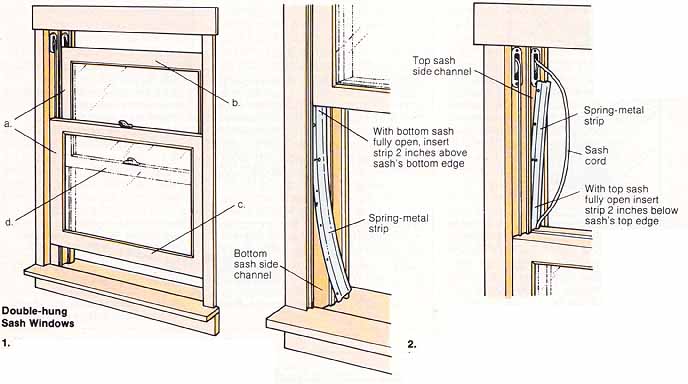
Double-hung sash window: 1. Measure
strips to fit (a) the side channels for both sashes; (b) the upper rail of
the top sash; (c) the lower rail of the bottom sash; and (d) the lower rail
of the top sash (the center bar). Cut strips with tin snips. 2.
Slide the side channel strips into place between the sashes and casements and nail in place. Do not cover the pulleys in the upper parts of the channels.
With bottom sash fully open, insert strip 2 inches above sash’s bottom edge;
Spring-metal strip; Sash cord; With top sash fully open insert strip 2 inches
below sash’s top edge.
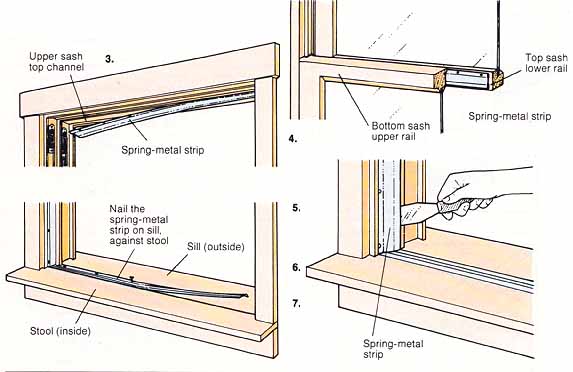
3. Slide the upper-rail,
top-sash strip into the window’s top channel, and the lower-rail, bottom-sash
strip into the window’s bottom channel, and nail in place. Or, as an alter
native, nail the upper-rail, top-sash strip to the top of the upper sash, and nail the lower-rail, bottom-sash strip to the underside of the bottom
sash. 4. Nail your last strip to the inside of the lower
rail of the top sash (the center bar). 5. Pry out the side
channel flanges with a screwdriver or a putty knife if you want to tighten
the seal. 6. Countersink all nails to prevent snagging. 7. Sit
back and admire your work.
• Sliding windows: If you want to weatherstrip a sliding window, the steps are the same. Just imagine it’s a double- hung sash window that’s lying on its side. If only one sash slides, use tension spring stripping in the channel that opens, and seal the three remaining edges of the moveable sash with tubular gasket stripping to create a good seal all around the sliding sash.
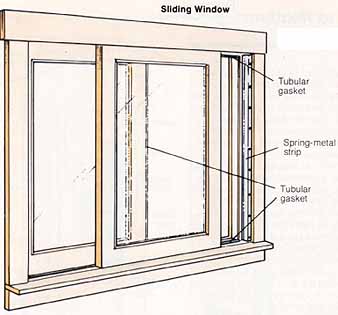
Sliding Window: Tubular gasket; Spring-metal strip; Tubular gasket
• Casement windows: For a casement window or any other kind of tilting window, nail the weatherstripping to the frame with the flange along the edge toward which the window opens. If you have a metal casement window and can not nail into its frame, buy a deeply grooved gasket stripping that can be fitted over all the metal edges of the window frame (available at most hard ware stores). To make this stripping hold better, first apply a rubber/metal or a vinyl/metal glue to the frame edge or the gasket channel.
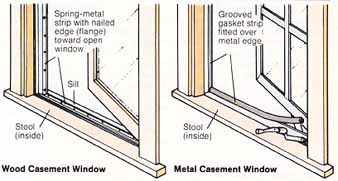
Wood/Metal casement windows.
• Other weatherstripping methods: Different types of weatherstripping re quire varied installation methods. Some of those variations are illustrated below.
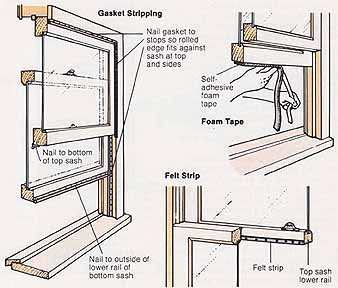
Gasket stripping: Nail gasket to stops
so rolled edge fits against sash at top and sides. Foam tape. Felt strip.
Gasket stripping. Vinyl or rubber gasket stripping can simply be tacked all around the sash. To make your gasket stripping less visible, it’s best to nail it to the outside of the window frame; but inside or out, it should fit tightly all around, including the lower rail of the top sash. Nail gasket stripping to the window frame with the thick or bulbous side against the sash. Make sure that the rolled edges fit tightly against the window when it’s closed. Then add strip ping to the lower rail of the top sash (the center bar) on the inside edge, to make a tight seal between the sashes when the whole window is closed. As with tension spring stripping, make sure to strip all edges of the window.
Foam tape. Foam tape or any other adhesive-backed stripping may be simply pressed into place with your fingers. Clean the surface so the tape can ad here. Then apply the stripping, slowly pulling paper or plastic backing off the tape as you go. Do not use this type of weatherstripping where it will encounter friction, such as in side channels—it will wear out quickly, or even pull right off.
Felt stripping. To install felt stripping, you can either staple it in place with an ordinary heavy-duty stapler, or you can nail the felt to the window frame, as with gasket stripping. Also add a length of felt to the inside of the lower rail of the top sash, to block infiltration from between the sashes. However, you should not attach felt stripping to the outside of a window where it is liable to get wet because it may rot, and you would have to replace it sooner than you might otherwise. and as with foam tape, do not use felt stripping where it will encounter friction.
Next: How to Weatherstrip a Door